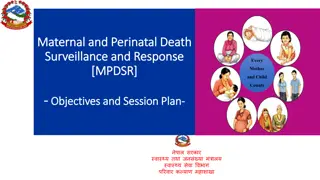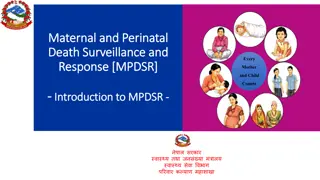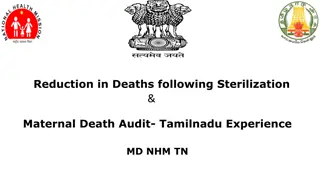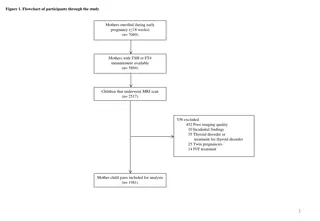Using the Partograph to Improve Maternal Child Health
Learn how to use the partograph to monitor labor progress and identify at-risk mothers and babies in a family medicine specialist CME event. Case studies illustrate the application of the partograph in managing labor complications effectively.
Download Presentation

Please find below an Image/Link to download the presentation.
The content on the website is provided AS IS for your information and personal use only. It may not be sold, licensed, or shared on other websites without obtaining consent from the author.If you encounter any issues during the download, it is possible that the publisher has removed the file from their server.
You are allowed to download the files provided on this website for personal or commercial use, subject to the condition that they are used lawfully. All files are the property of their respective owners.
The content on the website is provided AS IS for your information and personal use only. It may not be sold, licensed, or shared on other websites without obtaining consent from the author.
E N D
Presentation Transcript
Using the Partograph to Improve Maternal Child Health Family Medicine Specialist CME October 15-17, 2012 Pakse
Objectives: Review how to use and read a partograph Using case studies, identify mothers / babies who are at riskof morbidity or mortality and discuss management
Case 1 24yo G3P2 at 39w4d presents to the district hospital with regular, painful contractions that started earlier this morning. Her initial examination reveals her cervical dilatation to be 4cm After 3 hours, her cervical exam is now 8cm dilated
Questions: 1) When does active labor begin? Regular, painful contractions resulting in cervical dilatation of 3cm
2) What is the expected rate of cervical dilatation? 1cm/hr Dilation less than 2cm over 4 hours is dystocia, and requires intervention
3) Is her progress in labour adequate? (Use the partograph to determine).
X X
After another 20 minutes, her membranes rupture and she delivers a healthy baby shortly after.
Case 2 An 18yo G1P0 presents to the district hospital having contractions every 5-10 minutes for the last 1 hour. When the nurse checks her, she is 1cm dilated, with her cervix long, thick and firm. The fetal heart rate is 140bpm.
Questions 1) Is she in active labour? No, not until cervical dilatation is 3cm Cervical dilatation can be plotted in the Latent Labour section of the Partograph Latent labor should be less than 8 hours .
Discussion Question 3) What would you recommend for her at this stage at your district hospital? 4) If she is very uncomfortable with the contractions, what do you recommend for pain?
In 6 hours she returns having contractions every 2-3 minutes, that are more regular and painful. Now when the nurse checks her, her cervical dilatation is 3-4 cm Fetal heart rate is 135-140 bpm
X X X
After 4 hours, she is checked again, and is now 6cm. A bulge of membranes is felt. Plot this on the Partograph.
X X X X
Question 1) What would you do now? Now the graph is plotting in the ALERT zone which means that the labor is not progressing as quickly as expected (less than 1cm/hr). Now needs frequent reassesment to watch for progress. Once past the ALERT line, the patient MUST be transferred to a higher level hospital with obstetric services
She is transferred to a hospital with obstetrical services. Fetal heartrate is 130-135 beats per minute, and no decelerations. After another 3 hours, her cervical exam is still 6cm dilated. Descent is still +5.
X X X X X
What do you do now? Now on the ACTION line Definitive action must now be taken to address the slow progress. This may include Decision to augment labour with oxytocin, or Decision to proceed to operative delivery dependent on fetal wellbeing
The fetal heart rate is 120, with decelerations after every contraction down to 70 bpm, lasting 30-60 seconds. The membranes are ruptured, and meconium is noted. A decision is made to proceed with operative delivery.
Discussion What options exist in your district hospitals for dealing with labour dystocia? How long does it take to get to a hospital that can perform C/S?
Case 3 A 27yo G1P0 has been admitted to the hospital in active labor. At 08:00, she was 4cm dilated, descent +5 At 12:00, she was 10cm dilated, descent +3 Plot both cervical dilation and station on the Partograph
X O X O
She begins the Second Stage of labor, active pushing at 12:00h At 13:00h, the station is determined to be +2
X O X O O
Questions 1) How do you measure descent in labour? 2) What are the causes of slow descent, or dystocia in labour? 2) Is this patient showing adequate progress in the second stage of labour?
Measurement of Fetal Descent Measured by the number of fingerwidths that can be applied to the fetal head above the pelvic brim Head accomodates 5 fingers above the pelvic brim
Descent should be at an approximate rate of 1cm/hr in the second stage of labour Plotting descent helps identify when descent has stopped It is normal to see no descent until the cervix is more than 7cm dilated
Causes of Labour Dystocia in the Second Stage Slow or no descent can be caused by: Inadequate power of the uterine contractions Improperly positioned fetal head Inadequate pelvic space to accomodate the fetal head Pain in labour Psychological issues with the patient (scared to push, unwilling to push)
After another hour of pushing, descent is again assessed, and determined to be +2
X O X O OO
You make the diagnosis of poor progress in the second stage, and take action.
Discussion Questions What options are available at the district hospital to deal with second stage dystocia (no descent)?























